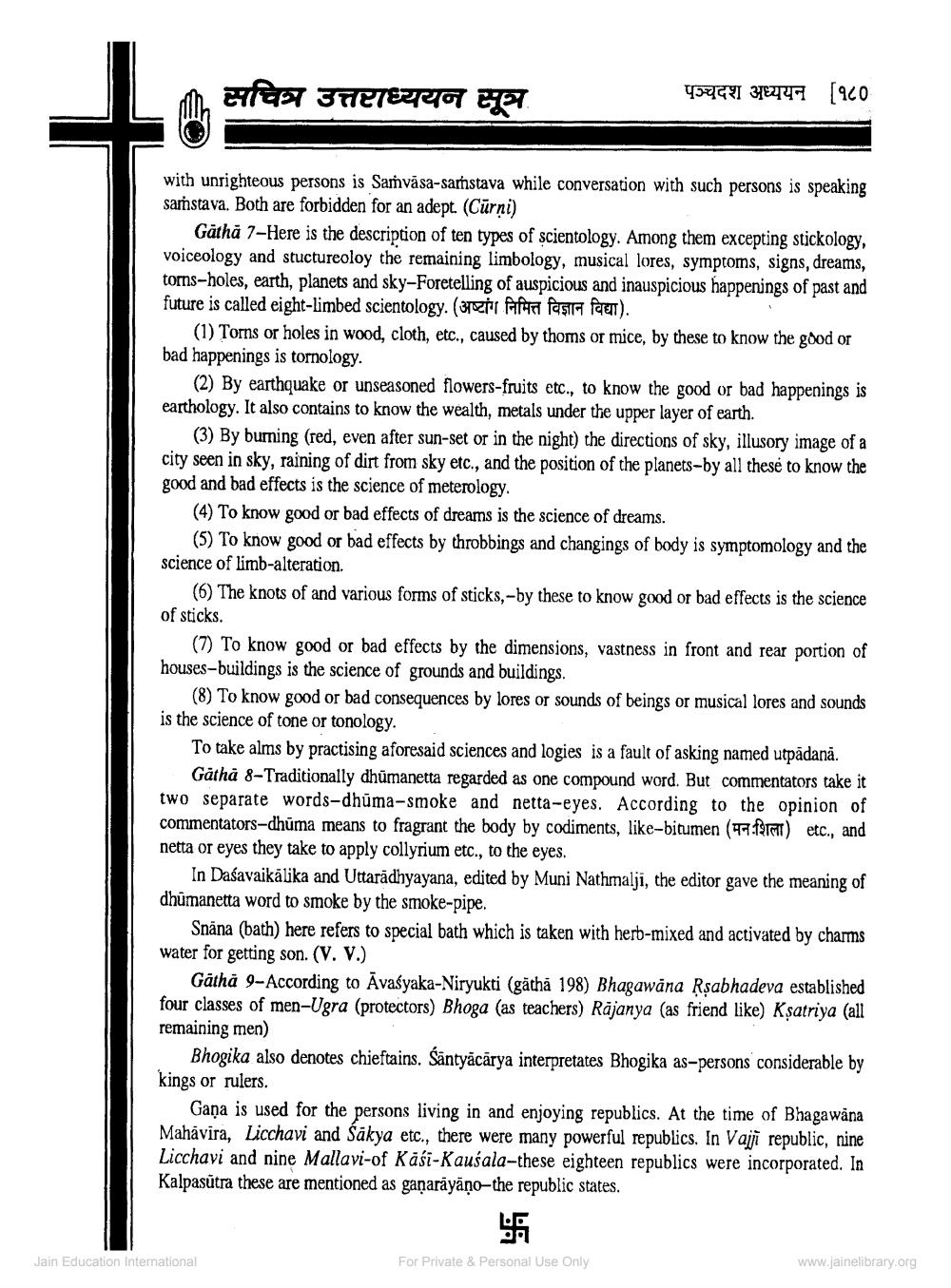________________
In सचित्र उत्तराध्ययन सूत्र
पञ्चदश अध्ययन [१८०
with unrighteous persons is Saṁvāsa-samstava while conversation with such persons is speaking saístava. Both are forbidden for an adept. (Cūrni)
Gathā 7-Here is the description of ten types of scientology. Among them excepting stickology, voiceology and stuctureoloy the remaining limbology, musical lores, symptoms, signs, dreams, torns-holes, earth, planets and sky-Foretelling of auspicious and inauspicious happenings of past and future is called eight-limbed scientology. (Get fafa fasta farem).
(1) Toms or holes in wood, cloth, etc., caused by thoms or mice, by these to know the good or bad happenings is tornology.
(2) By earthquake or unseasoned flowers-fruits etc., to know the good or bad happenings is earthology. It also contains to know the wealth, metals under the upper layer of earth.
(3) By burning (red, even after sun-set or in the night) the directions of sky, illusory image of a city seen in sky, raining of dirt from sky etc., and the position of the planets-by all these to know the good and bad effects is the science of meterology.
(4) To know good or bad effects of dreams is the science of dreams.
(5) To know good or bad effects by throbbings and changings of body is symptomology and the science of limb-alteration.
(6) The knots of and various forms of sticks, - by these to know good or bad effects is the science of sticks.
(7) To know good or bad effects by the dimensions, vastness in front and rear portion of houses-buildings is the science of grounds and buildings.
(8) To know good or bad consequences by lores or sounds of beings or musical lores and sounds is the science of tone or tonology.
To take alms by practising aforesaid sciences and logies is a fault of asking named utpādanā.
Gäthä 8-Traditionally dhūmanetta regarded as one compound word. But commentators take it two separate words-dhūma-smoke and netta-eyes. According to the opinion of commentators-dhūma means to fragrant the body by codiments, like-bitumen (. ) etc., and netta or eyes they take to apply collyrium etc., to the eyes.
In Daśavaikälika and Uttarādhyayana, edited by Muni Nathmalji, the editor gave the meaning of dhūmanetta word to smoke by the smoke-pipe.
Snåna (bath) here refers to special bath which is taken with herb-mixed and activated by charms water for getting son. (V. V.)
Gatha 9-According to Avaśyaka-Niryukti (gātha 198) Bhagawana Rsabhadeva established four classes of men-Ugra (protectors) Bhoga (as teachers) Rājanya (as friend like) Ksatriya (all remaining men)
Bhogika also denotes chieftains. Säntyācārya interpretates Bhogika as-persons considerable by kings or rulers.
Gana is used for the persons living in and enjoying republics. At the time of Bhagawāna Mahavira, Licchavi and Sakya etc., there were many powerful republics. In Vaji republic, nine Licchavi and nine Mallavi-of Kasi-Kausala-these eighteen republics were incorporated. In Kalpasūtra these are mentioned as gañarāyāņo-the republic states.
Jain Education International
For Private & Personal Use Only
www.jainelibrary.org




